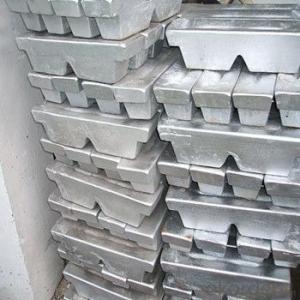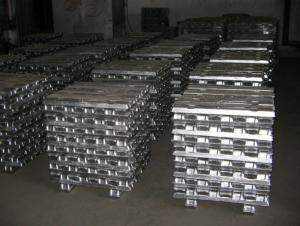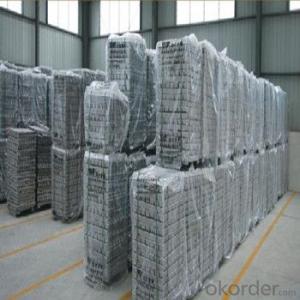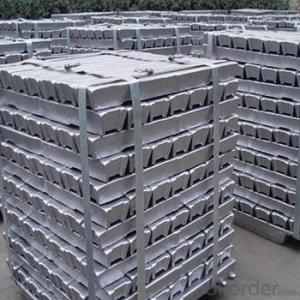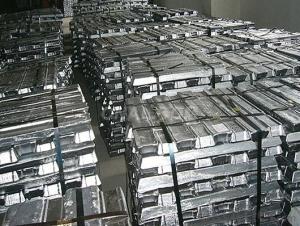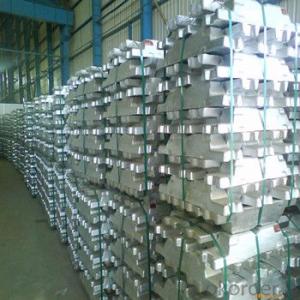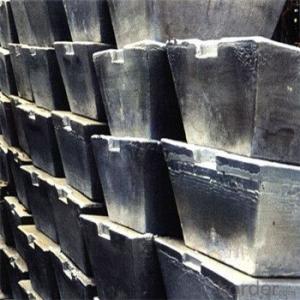Aluminum Ingot 99.9% with Best Price and High Purity
- Loading Port:
- China main port
- Payment Terms:
- TT OR LC
- Min Order Qty:
- 1000 m.t.
- Supply Capability:
- 10000 m.t./month
OKorder Service Pledge
OKorder Financial Service
You Might Also Like
Pure Aluminum Ingot Used for Industry
1.Structure of Aluminum Ingot Description
Aluminum Ingot is with the AL as the main chemical composition. Aluminum Ingot is used for industry,such as automobile,pinning and weaving,electron broadly and so on. Aluminum Ingot has the following advantages: easy control and operation, fast melting.
2.Main Features of the Aluminum Ingot
•High Purity
•Easy control and operation
•High strength
•Fast melting
•Competitive price
•Best Service
3. Aluminum Ingot Images
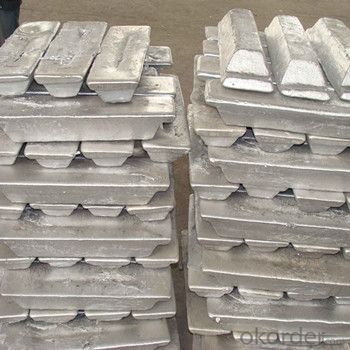

4. Aluminum Ingot Specification
Grade | Chemical Composition % | |||||||||
Al≥ | impurities ≤ | |||||||||
Si | Fe | Cu | Ga | Mg | Zn | Mn | others | Sum | ||
Al99.9 | 99.90 | 0.50 | 0.07 | 0.005 | 0.02 | 0.01 | 0.025 | - | 0.010 | 0.10 |
Al99.85 | 99.85 | 0.80 | 0.12 | 0.005 | 0.03 | 0.02 | 0.030 | - | 0.015 | 0.15 |
Al99.7 | 99.70 | 0.10 | 0.20 | 0.010 | 0.03 | 0.02 | 0.030 | - | 0.030 | 0.30 |
Al99.6 | 99.60 | 0.16 | 0.25 | 0.010 | 0.03 | 0.03 | 0.030 | - | 0.030 | 0.40 |
Al99.5 | 99.50 | 0.22 | 0.30 | 0.020 | 0.03 | 0.05 | 0.050 | - | 0.030 | 0.50 |
Al99.00 | 99.00 | 0.42 | 0.50 | 0.020 | 0.03 | 0.05 | 0.050 | - | 0.050 | 1.00 |
5.FAQ of Aluminum Ingot
We have organized several common questions for our clients,may help you sincerely:
①How about your company?
A world class manufacturer & supplier of castings forging in carbon steel and alloy steel,is one of the large-scale professional investment casting production bases in China,consisting of both casting foundry forging and machining factory. Annually more than 8000 tons Precision casting and forging parts are exported to markets in Europe,America and Japan. OEM casting and forging service available according to customer’s requirements.
②How to guarantee the quality of the products?
We have established the international advanced quality management system,every link from raw material to final product we have strict quality test;We resolutely put an end to unqualified products flowing into the market. At the same time, we will provide necessary follow-up service assurance.
③How long can we receive the product after purchase?
In the purchase of product within three working days, We will arrange the factory delivery as soon as possible. The pecific time of receiving is related to the state and position of customers.Commonly 7 to 10 working days can be served.
- Q:How are aluminum ingots used in the production of sports equipment?
- The lightweight, durable, and corrosion-resistant properties of aluminum ingots make them widely used in the production of sports equipment. Various sports gear, including baseball bats, tennis rackets, golf clubs, and bicycles, heavily rely on these ingots as the primary material. To manufacture the sports equipment, the aluminum ingots are first melted and then poured into molds to achieve the desired shape and size. Once the molten aluminum cools and solidifies, a strong and solid structure is formed. The lightweight nature of aluminum ingots is one of their major advantages. This characteristic makes the sports equipment easier to handle and maneuver, reducing the effort exerted by athletes during play. For instance, aluminum baseball bats are recognized for their lightweight design, allowing players to swing the bat with greater speed and precision. Furthermore, aluminum ingots offer excellent durability, ensuring that the sports equipment has a longer lifespan. They are resistant to wear and tear, making them suitable for intense sports activities. For example, aluminum tennis rackets can withstand the impact of tennis balls and maintain their shape and performance over an extended period. Moreover, aluminum ingots possess exceptional corrosion resistance, which is particularly advantageous for sports equipment exposed to various environmental conditions, such as bicycles. Aluminum bicycle frames made from ingots are resistant to rust and corrosion, resulting in an extended lifespan and improved performance. In conclusion, aluminum ingots play a vital role in the production of high-quality and high-performance sports equipment. Their lightweight, durable, and corrosion-resistant properties contribute to the creation of sports gear that enables athletes to excel in their respective sports.
- Q:102 non-standard aluminum ingot is like? And ordinary non-standard aluminum ingot what is the difference?
- Ordinary non-standard aluminum ingot is the tube you use, regardless of your standard, with miscellaneous aluminum recovery smelting out of the aluminum ingot.
- Q:Difference between ingots and alumina
- In a word, alumina can be used to make ingots, and aluminium ingots are a large aluminum block
- Q:How do aluminum ingots contribute to the circular economy?
- Aluminum ingots play a significant role in contributing to the circular economy due to their recyclability and multiple applications. The circular economy is an economic system aimed at minimizing waste and maximizing the value of resources by promoting reuse, recycling, and remanufacturing. One key aspect of aluminum ingots is their recyclability. Aluminum is one of the most recycled materials globally, with a recycling rate of around 70-80%. This means that a large portion of aluminum used in various products can be recycled and transformed into new aluminum ingots. This recycling process requires significantly less energy compared to primary aluminum production, resulting in reduced greenhouse gas emissions and a lower environmental footprint. Moreover, aluminum ingots have numerous applications across various industries, including construction, automotive, aerospace, packaging, and electronics. By using recycled aluminum ingots, these industries can reduce their dependence on virgin (primary) aluminum extraction, which is an energy-intensive process. The use of recycled aluminum ingots not only conserves natural resources but also helps in reducing carbon emissions associated with primary aluminum production. Additionally, the circular economy approach encourages the design and production of products with recyclability in mind. Aluminum ingots can be easily melted down and reshaped into various forms, allowing for the creation of new products while maintaining their quality. This closed-loop system ensures that aluminum remains in circulation, reducing the need for raw material extraction and minimizing waste generation. In conclusion, aluminum ingots contribute to the circular economy by being highly recyclable, enabling the transformation of waste aluminum into valuable resources. Their use in various industries promotes sustainability, reduces energy consumption, and minimizes waste, making aluminum ingots an essential component in the transition to a more circular and resource-efficient economy.
- Q:How are aluminum ingots used in the production of furniture?
- Aluminum ingots are commonly used in the production of furniture as they serve as the primary material for manufacturing metal furniture frames. These ingots are melted down and cast into various shapes and sizes to create sturdy and lightweight frames for chairs, tables, cabinets, and other furniture items. The versatility and durability of aluminum make it an ideal choice for furniture production as it allows for intricate designs and long-lasting structures.
- Q:What are the common defects found in aluminum ingots?
- Common defects found in aluminum ingots include shrinkage porosity, hot tearing, gas porosity, inclusions, segregation, and surface cracks. These defects can negatively impact the quality and mechanical properties of the aluminum ingots, leading to potential issues during subsequent processing and manufacturing.
- Q:How are aluminum ingots used in the production of cookware?
- Aluminum ingots play a crucial role in the production of cookware due to their unique properties. These ingots are melted down and then shaped into desired cookware forms, such as pots, pans, and baking sheets. One of the main reasons aluminum is widely used in cookware production is its excellent heat conductivity. Aluminum conducts heat more efficiently than other metals, which ensures even heat distribution across the entire surface of the cookware. This property allows for consistent cooking results, preventing hotspots and reducing the risk of food burning or sticking to the pan. Moreover, aluminum is lightweight and easy to handle, making it a popular choice for cookware. This feature is particularly beneficial for individuals with limited strength or mobility, as it enables them to maneuver and lift the cookware without much effort. However, pure aluminum is relatively soft and susceptible to scratches and dents. To improve its durability, aluminum ingots are often alloyed with other metals, such as copper or stainless steel, during the cookware manufacturing process. These alloys enhance the strength and hardness of the cookware while retaining the excellent heat conductivity of aluminum. Additionally, aluminum is non-reactive, meaning it does not interact with acidic or alkaline foods. This characteristic ensures that the taste and quality of the cooked food are not affected by the cookware material. Furthermore, aluminum cookware is generally affordable, making it accessible to a wide range of consumers. Its cost-effectiveness, combined with its excellent cooking performance, has made aluminum cookware a staple in many kitchens around the world. In conclusion, aluminum ingots are indispensable in the production of cookware due to their excellent heat conductivity, lightweight nature, and non-reactive properties. By utilizing aluminum ingots, manufacturers can create cookware that provides even heat distribution, durability, and affordability to enhance the cooking experience for consumers.
- Q:Yl302 aluminum ingot is alumina alloy?
- Used in the manufacture of castings, die cast aluminium is the type of aluminum alloy used in the production of castings by die casting.
- Q:How are aluminum ingots used in the production of architectural structures?
- Aluminum ingots are commonly used in the production of architectural structures due to their lightweight, durability, and corrosion resistance properties. These ingots are melted down and cast into various shapes, such as beams, columns, and panels, which form the structural framework of buildings. The versatility of aluminum allows for the creation of intricate designs and enables architects to push the boundaries of innovative and sustainable architecture. Moreover, aluminum ingots can be easily recycled, making them an environmentally friendly choice for construction projects.
- Q:How are aluminum ingots used in the production of transportation vehicles?
- Aluminum ingots play a crucial role in the production of transportation vehicles, especially in the automotive and aerospace industries. These ingots are melted down and cast into various components that are lightweight, yet strong and durable. In automotive manufacturing, aluminum ingots are primarily used to produce engine blocks, cylinder heads, and transmission casings. The lightweight nature of aluminum allows vehicles to achieve better fuel efficiency and lower emissions. Additionally, aluminum's high strength-to-weight ratio enhances the overall performance and safety of the vehicle. Aluminum ingots are also utilized in the aerospace industry for the construction of aircraft components. These ingots are transformed into structural parts such as wing panels, fuselage sections, and landing gear. The lightweight properties of aluminum contribute to increased fuel efficiency, enabling aircraft to carry more passengers or cargo over longer distances. Furthermore, aluminum ingots are employed in the production of railway and marine vehicles. In railways, aluminum components are used for train bodies, doors, and windows, enhancing both speed and energy efficiency. Similarly, aluminum ingots are utilized in marine vessels for constructing hulls, decks, and superstructures, contributing to better maneuverability, fuel economy, and corrosion resistance. The use of aluminum ingots in transportation vehicles offers numerous advantages, including improved performance, reduced weight, enhanced fuel efficiency, and increased durability. As a result, the demand for aluminum ingots in the transportation industry continues to grow, driving innovation and advancements in materials engineering.
1. Manufacturer Overview |
|
|---|---|
| Location | |
| Year Established | |
| Annual Output Value | |
| Main Markets | |
| Company Certifications | |
2. Manufacturer Certificates |
|
|---|---|
| a) Certification Name | |
| Range | |
| Reference | |
| Validity Period | |
3. Manufacturer Capability |
|
|---|---|
| a)Trade Capacity | |
| Nearest Port | |
| Export Percentage | |
| No.of Employees in Trade Department | |
| Language Spoken: | |
| b)Factory Information | |
| Factory Size: | |
| No. of Production Lines | |
| Contract Manufacturing | |
| Product Price Range | |
Send your message to us
Aluminum Ingot 99.9% with Best Price and High Purity
- Loading Port:
- China main port
- Payment Terms:
- TT OR LC
- Min Order Qty:
- 1000 m.t.
- Supply Capability:
- 10000 m.t./month
OKorder Service Pledge
OKorder Financial Service
Similar products
New products
Hot products
Hot Searches
Related keywords
